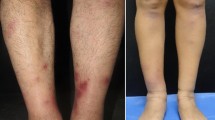Summary
The occurrence and development of microprecipitin antibodies to poliovirus antigens was investigated with sera derived from triplenegative persons, triple-positive naturally, immune persons, persons immunized by killed or live poliovirus vaccines, persons with clinical poliomyelitis caused by each of the 3 types of poliovirus, and persons infected with various Coxsackie and ECHO viruses.
No positive reactions were obtained in sera of 11 triple-negative children and adults. Seven of 44 (16 per cent) sera from healthy, naturally immune children and adults gave positive reactions. Sera from persons who ingested live, attenuated poliovirus vaccine all developed precipitin antibody, which however was detected later than the neutralizing antibody. The response to 4 doses of Salk vaccine was less frequent and marked, and occurred most often in persons who had naturally acquired neutralizing antibodies for the corresponding type of poliovirus prior to vaccination.
Thirty-two of 36 patients with poliomyelitis developed a positive precipitin reaction which was already, as a rule, present in maximum titers at the end of the first week after onset of illness. Precipitin antibody titers began to decline within a few weeks after onset of illness. Similar rapid declines were observed after infection with live virus vaccine, and after inoculation of Salk vaccine.
The polio-precipitin reaction was type-specific in patients apparently infected for the first time with poliovirus, but heterotypic reactions occurred frequently in patients with pre-existing heterotypic neutralizing antibodies. There was some indication that Coxsackie A 9 and the polioviruses may share a minor, common microprecipitin antigen. The available data indicate that the microprecipitin antibody is different from both the neutralizing and complement-fixing antibodies.
The advantages and limitations of the polio-precipitin test as a diagnostic procedure are discussed.
Similar content being viewed by others
Bibliography
Eggers, H. J., andA. B. Sabin: A phase contrast microprecipitin test with poliovirus antigens. I. Properties of the antigens and antibodies and optimum conditions for reaction. Arch. ges. Virusforsch.11, 120 (1961).
Churcher, G.: in Poliomyelitis. Papers and Discussions Presented at the Fourth International Poliomyelitis Conference. J. B. Lippincott Company 398 (1958).
Sabin, A. B.: Properties of attenuated polioviruses and their behavior in human, beings. Special Publications of the New York Academy of Sciences5, 113 (1957).
Sabin, A. B.: Present position of immunization against poliomyelitis with live virus vaccines. Brit. Med. J.1, 663 (1959).
Sabin, A. B.: Properties and behaviour of orally administered attenuated poliovirus vaccine. J. Am. Med. Assn.164, 1216 (1957).
Sabin, A. B.: Prevention of poliomyelitis by vaccination, chapter in Advances in Pediatrics10, 197 (1958).
Johnson, T., E. Lycke, B. Wictorin, andB. Jonnson: Studies of an epidemic of aseptic meningitis in association with. Coxsackie and ECHO viruses. II. Serological and clinical observations. Arch. ges. Virusforsch.8, 285 (1958).
Berglund, A., M. Böttinger, T. Johnsson, andS.-E. Westermark: An outbreak of aseptic meningitis with a rubella-like rash probably caused by ECHO virus Type 9, Arch. ges. Virusforsch.8, 294 (1958).
Johnsson, T., M. Böttiger, andA. Löfdahl: An outbreak of aseptic meningitis with a rubella-like rash probably caused by ECHO virus Type 4. Arch. ges. Virusforsch.8, 306 (1958).
Halonen, P., L. Rosen, andR. J. Huebner: Homologous and heterologous complement fixing antibody in persons infected with ECHO, Coxsackie and poliomyelitis viruses. Proc. Soc. Exp. Biol. and Med.101, 236 (1959).
Smith, W., G. P. B. Boissard, G. M. Churcher, andL. Parker: Poliomyelitis virus flocculation reaction. Behaviour of sera of cases and vaccinated individuals. Lancet277, 586 (1959).
Grasset, E., V. Bonifas, andE. Pongratz: Rapid slide precipitin microreaction of poliomyelitis antigens and antisera in agar. Proc. Soc. Exp. Biol. and Med.97, 72 (1958).
Le Bouvier, G. L.: Poliovirus precipitins. A study by means of diffusion in agar. J. Exp. Med.106, 661 (1957).
Paul, J. R., J. T. Riordan, andJ. L. Melnick: Antibodies to three different antigenic types of poliomyelitis virus in sera from North Alaskan Eskimos. Am. J. Hyg.54, 275 (1951).
Winsser, J., andA. B. Sabin: Levels of homotypic neutralizing antibody in human poliomyelitis three years after infection. J. Exp. Med.96, 477 (1952).
Lennette, E. H., andN. J. Schmidt: Studies on the development and persistence of complement-fixing and neutralizing antibodies in human poliomyelitis. Am. J. Hyg.65, 210 (1957).
Le Bouvier, G. L.: On the rise and decline of poliovirus antibodies in different human populations. Am. J. Hyg.66, 342 (1957).
Schmidt, N. J., andE. H. Lennette: A microflocculation test for poliomyelitis with observations on the flocculating antibody response in human poliomyelitis. Am. J. Hyg.70, 51 (1959).
Le Bouvier, G. L.: The modification of poliovirus antigens by heat and ultraviolet light. Lancet269, 1013 (1955).
Schmidt, N. J., andE. H. Lennette: Modification of the homotypic specificity of poliomyelitis complement-fixing antigens by heat J. Exp. Med.104, 99 (1956).
Author information
Authors and Affiliations
Additional information
Aided by grants from The National Foundation, Inc.
Rights and permissions
About this article
Cite this article
Eggers, H.J., Sabin, A.B. A phase contrast microprecipitin test with poliovirus antigens. Archiv f Virusforschung 11, 152–175 (1961). https://doi.org/10.1007/BF01241254
Received:
Issue Date:
DOI: https://doi.org/10.1007/BF01241254




